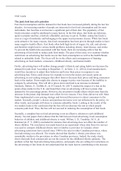1046 words
The junk food ban ad is pointless
Fast-food consumption and the demand for fast foods have increased globally during the last few
decades. An increasing number of people are interested in fast food consumption and for most
individuals, fast food has even become a significant part of their diet. The popularity of fast
foods nowadays could be attributed to many factors. In the first place, fast foods are delicious,
quick to prepare and buy, relatively affordable, and easy to get to. Further, eating fast foods is
seen as a sign of modernity and belonging to the upper socioeconomic classes. While fast foods
seem attractive for many reasons, fast-food consumption has been proven through studies to have
many negative health effects. Fast foods often hold high levels of sugars, fat, salt, and calories
and therefore might lead to various health problems including obesity, heart disease, and stroke.
To prevent the health risks associated with fast foods, there are increasing calls to ban the
advertising of fast foods to reduce junk food intake. The goal of this essay is to examine whether
restrictions on advertising fast foods can cut fast food consumption as well as the health threats
related to unhealthy foods. The focus will be on the effects and consequences of banning
advertising on food markets, consumers, childhood obesity, and human health.
Firstly, advertising bans will neither change people’s lifestyle and eating habits nor decrease the
demand for junk food. According to Requillart, V., & Soler, L. G. (2014), food manufacturers
would face incentives to adjust their behavior and lower their prices in response to any
advertising ban. Firms could choose for example to invest the money previously spent on
advertising in cost-cutting strategies that allow them to decrease their prices and bring consumers
back to the market. Firms might also choose to engage in price wars because of the inability to
compete by advertising. This will drive prices down and lead to an increase in demand.
Similarly, Dubois, P., Griffith, R., & O’Connell, M. (2017) studied the impact of a ban on the
potato chips market in the U.K. and found that a ban on advertising will lower potato chip
demand by five percentage points. However, the net positive health effects which arise from the
decrease in the potato chip demand were offset for two reasons. First, firms did not sit still. Most
firms implemented a new pricing strategy and lowered their prices to attract consumers to the
market. Secondly, people’s choices and purchase decisions were not influenced by the policy. In
other words, most people still chose to consume unhealthy foods. Looking at the results of the
two studies leads to the conclusion that the ban will not decrease the rate at which people
consume junk food. Thus, the ban will not succeed in reducing the consumption of fast foods.
Secondly, a complete ban on food advertising is not an effective solution to curb childhood
obesity. Several papers find evidence that the link between food advertising, food consumption
behavior of children, and childhood obesity is weak. Willms, J. D., Tremblay, M. S., &
Katzmarzyk, P. T. (2003) concluded for instance that advertising does not affect the number of
obese children. The conclusion was made based on an experiment where data from two surveys
was used to compare childhood obesity rates in Quebec (a province in Canada), where
advertising restrictions have existed since 1980 to the rates in other Canadian provinces, where
food advertising was allowed. The results showed that Quebec’s obesity prevalence was
remarkably similar to the prevalence in other Canadian provinces. Indeed, the study clearly
shows that junk food commercials are not the reason for the childhood obesity epidemic. The
problem is that fast food advertising bans policies, and people who are calling for restrictions on
the advertising of fast foods do not understand that the main factors contributing to the increase





